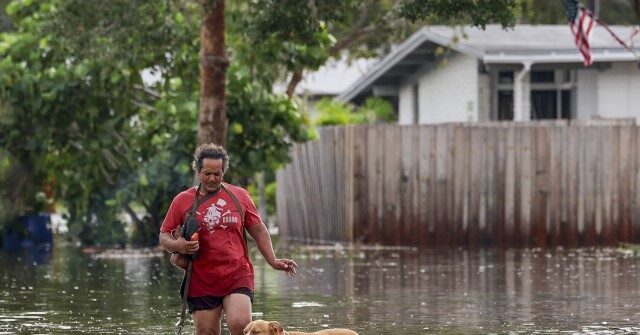Climate alarmists have reacted to hurricane season with predictable hysteria, seeing in every storm further confirmation of their worst doomsday fears.
A case in point is Jan Wondra, writing for Ark Valley Voice, who suggests that Hurricane Helene proves no place on earth is immune from the effects of global warming and may be a harbinger of an impending “climate breakdown.”
Wondra even goes so far as to cite the 2004 apocalyptic climate thriller “Day After Tomorrow” to warn readers their direst fears are true and the end is indeed nigh.
The “ominous signs are everywhere,” she writes, and even “places that were assumed safe — or safer– from the impacts of extreme weather are proving not to be as immune from growing climate changes.”
The “horrifyingly real” reality is that the changes occurring in our climate are global and no place is completely safe from climate change, she declares.
In other words, be very afraid: death by weather is coming for you.
It Just Doesn’t Stop! Tornado Spotted in Florida Ahead of Hurricane Milton Landfall
Koby Kreiger /TMX
Keeping strictly to the alarmist script, however, Wondra does not cite deaths from extreme weather events — which are decreasing each year and now are a tiny fraction of what they were 100 years ago — and writes instead about the dollar cost of damage.
Even this is misleading, however. As climate expert Bjorn Lomborg noted in a 2021 op-ed in the Wall Street Journal, measuring the total damage of natural disasters over time misses the important point, namely that “there’s much more stuff to damage today than there was several decades ago.”
“As the world has gotten richer and its population has grown, the number and quality of structures in the path of floods, fires, and hurricanes have risen,” he added.
A much more accurate measure even of the cost of weather-related damage is found by looking at damage as a percent of gross domestic product, Lomborg reasoned, and the trend of weather-related damages from 1990 to 2020 declined from 0.26 percent of global GDP to just 0.18 percent.
Hurricanes are not the only phenomenon getting alarmists excited, however.
Over at Gizmodo, folks are actually upset about the greening of Antarctica, which “isn’t supposed” to happen.
Florida Police Leap in to Secure and Anchor Boat During Helene Flooding
Sarasota Police Department via Storyful
If you foolishly thought that recovering green space was actually a good thing for humanity, science writer Passant Rabie is here to set you straight, declaring that Antarctica is turning green at an “alarming rate” as “events of extreme heat” have reshaped the continent’s landscape over the past few decades.
Using satellite data, a team of scientists captured the “dramatic increase” in vegetation across the Antarctic Peninsula, Rabie notes with horror. “They found that vegetation increased more than tenfold from 1986 to 2021, growing from 0.39 square miles (1 square kilometer) to almost 4.6 square miles (12 square kilometers).”
This year, Antarctica experienced its “most extreme heatwave on record,” she laments, with temperatures climbing up to 50 degrees Fahrenheit (28 degrees Celsius) above normal in mid-July.
What Ms. Rabie fails to mention is that the average yearly temperature in the interior of Antarctica is −43.5 °C (−46.3 °F). Even 50 ºF higher is still well below freezing and hardly constitutes a “heatwave” to anyone except the most ideologically driven.
For some, even the good news of added green spaces is cause for mourning.



